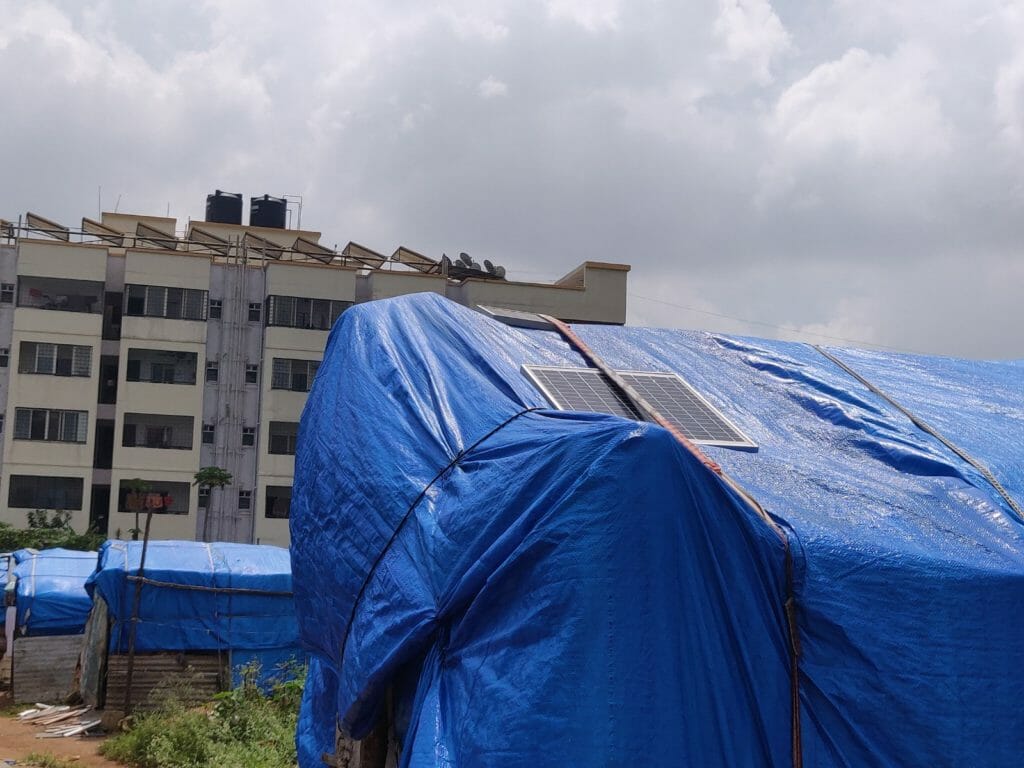As of December 2022, I complete five months at Citizen Matters. During this time, I have written articles across the verticals of civic, society, infrastructure, environment, and economy.
I have profiled how community-based learning can accelerate the education of children from lower rungs of the socio-economic strata, if recently established Namma Clinics can bridge the last-mile gap in healthcare, and elaborated on what the government does with traffic fines that are collected.
There were three stories, however, which received overwhelming responses from readers.
Brookefield settlement floods
One of my most challenging stories was when in my first month, I came across a lead on Twitter by the All India Central Council of Trade Unions, Karnataka who were scrambling to find aid and help the residents in an informal settlement in Brookefield, BEML Layout.
Read more: Homeless and penniless, families of Brookefield settlement blame adjacent tech park for flooding
This was during the terrible cases of urban flooding that the city’s eastern parts experienced, and social media was flooded with posts of water-soaked residents in higher-income apartments in Sarjapura and Whitefield complaining about the failures of urban planning. There were visuals of these residents having lost their belongings, their expensive private vehicles, and how they were collectively voicing their disdain online.
Amidst this, I found AICCTU’s account of the flooded settlement lost in the narrative. This prompted me to investigate what was missing in mainstream media. What I found out, which was important, was that while there were cases of urban flooding, the Brookefiled residents urged that the flooding they faced was not due to the torrential rains but because an adjacent tech park pumped out water from their submerged basement.

During my visit to the inundated settlement, what I also found was that in the self-constructed house, the residents were using solar panels atop the tarpaulin covers to power the appliances in their household. They hailed it to be a one-time investment of Rs 6,000 that allowed them to continue using their mixers and stoves. This also prompted me to think about how in conversations surrounding solar rooftops, the narrative is dominated by apartment complexes carrying out capital-intensive solar power projects.
However, post the flooding, the residents lost their solar panels along with their appliances and two-wheelers. I visited the settlement after the first bout of flooding, where the residents were returning from the community hall, where they were temporarily housed and provided with meals. Now that they were back, this loss was felt deeply because they couldn’t cook for themselves and had to resort to using firewood to make their meals. One of the residents informed me of how they had stopped using wood as fuel because of all the campaigns that informed them of the harm and were disheartened to resort to using them again.
The elusive rock agama
I attended the ATREE at 25 event, which was to celebrate 25 years of Ashoka Trust for Research in Ecology and Environment (ATREE). The two-day event consisted of engaging talks from domain experts, exhibitions on ecology, and stimulating conversations under the broad theme ‘Life and Lives’ that explored Naturescapes, Urbanscapes and Waterscapes.
Read more: Why you will rarely see the once-common Rock Agama lizard in Bengaluru today
During lunch, I came across a researcher who spoke about their latest research that looked at the prevalence or the lack thereof of a specific species across the Bengaluru agglomeration. When prodded, he explained how his team at the Centre for Ecological Sciences at Indian Insititute for Science, Bengaluru, had painstakingly collected data regarding the occurrence of the (now) elusive rock agama or Psammophilus dorsalis, and hypothesised and enlisted evidence for their disappearance.

When I approached him and his co-author for the story, they mentioned how the data also showed them what parts of the city the rock agama now retreated to, and they were able to match it with the changing land-use patterns and urbanscapes to discern the patterns and causes.
This was one of the first science communication pieces that I undertook, where I simplified scientific and technical research and built up a narrative that would be easily comprehensible and of interest to our readers. While this entailed listing out the principle findings of the study, it was also equally interesting to listen to the researchers speak about where their inquiry stemmed from, why was it required now, and how can readers personalise this.
The story was received well on Twitter and several readers and Twitter users corroborated the story, sharing their personal instances of not being able to spot the lizard as easily in the city as before. They also shared pictures of the times when they did successfully spot it, sunning itself on a rock- staying true to its name.
Attempt to make ORR stretch a separate municipal zone
This article was borne out of a Whatsapp conversation with my friends, both professionals working in the planning space, one on transport and the other on community design. The conversation started off with the Outer Ring Road Company Association (ORRCA)’s proposal to break the ORR stretch away from BBMP’s Mahadevapura for a separate municipal zone.

It was also the ability, if not the audacity, of the capital-rich ORR stretch to demand a privatised approach to their municipal problems. Having worked on articles detailing the failure of urban planning that caused the floods and the removal of stormwater drains that ensued after, I understood where the demand stemmed from. But the conversation with my friends also brought out concepts like how would informality (in the form of informal housing settlements or street-side vendors thrive) in a privatised municipal set up? How the demand reflected the need to be set apart from the rest of the city’s planning and governance, and inch closer to a “world-class” region shrouded behind the glass enclaves of the global tech companies.
Read more: Is an ELCITA model possible for ORR’s dense 17-km stretch?
While this was taking the shape of a research inquiry, I wanted to understand, through the article, how it is easier for money and big-wigs to bridge the gaps in sporadic municipal governance. How similar models of privatised governance have not only existed but also have done so successfully, such as ELCITA. But I still couldn’t quieten the niggling worry that reminded me of author Teresa Caldeira’s City of Walls, based in Sao Paulo, where segregation of residents was cemented through the monopolisation of planning and urban service delivery.